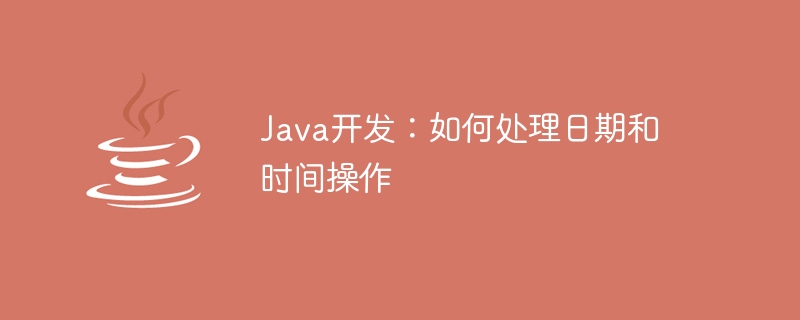

Java development: How to handle date and time operations, specific code examples are required
In Java development, date and time processing is a very common requirement. Whether you are calculating the difference between two dates, formatting dates, or getting the day before or after a specific date, you need to be proficient in the knowledge and skills of date and time processing. This article will introduce commonly used date and time operations in Java, and provide specific code examples for readers to refer to and learn from.
In Java, we can use thejava.util.Dateclass to represent the current date and time. The code example is as follows:
import java.util.Date; public class DateTimeDemo { public static void main(String[] args) { Date currentDate = new Date(); System.out.println("当前日期和时间:" + currentDate); } }
In actual development, we often need to display the date in a certain format, such as formatting the date as " "yyyy-MM-dd" or "yyyy-MM-dd HH:mm:ss" etc. Java provides thejava.text.SimpleDateFormatclass for date formatting. The code example is as follows:
import java.text.SimpleDateFormat; import java.util.Date; public class DateTimeDemo { public static void main(String[] args) { Date currentDate = new Date(); SimpleDateFormat dateFormat = new SimpleDateFormat("yyyy-MM-dd"); String formattedDate = dateFormat.format(currentDate); System.out.println("格式化后的日期:" + formattedDate); } }
In Java, we can use thejava.util.Calendarclass to calculate the difference between two dates. The code example is as follows:
import java.text.SimpleDateFormat; import java.util.Calendar; import java.util.Date; public class DateTimeDemo { public static void main(String[] args) { SimpleDateFormat dateFormat = new SimpleDateFormat("yyyy-MM-dd"); try { Date startDate = dateFormat.parse("2021-01-01"); Date endDate = dateFormat.parse("2021-12-31"); Calendar startCalendar = Calendar.getInstance(); startCalendar.setTime(startDate); Calendar endCalendar = Calendar.getInstance(); endCalendar.setTime(endDate); long days = (endCalendar.getTimeInMillis() - startCalendar.getTimeInMillis()) / (1000 * 60 * 60 * 24); System.out.println("两个日期之间的天数差距:" + days); } catch (Exception e) { e.printStackTrace(); } } }
In Java, we can usejava.util.CalendarClass to get the day before or the day after a specific date. The code example is as follows:
import java.text.SimpleDateFormat; import java.util.Calendar; import java.util.Date; public class DateTimeDemo { public static void main(String[] args) { SimpleDateFormat dateFormat = new SimpleDateFormat("yyyy-MM-dd"); try { Date currentDate = dateFormat.parse("2021-10-01"); Calendar calendar = Calendar.getInstance(); calendar.setTime(currentDate); // 获取前一天的日期 calendar.add(Calendar.DAY_OF_MONTH, -1); Date previousDate = calendar.getTime(); String formattedPreviousDate = dateFormat.format(previousDate); System.out.println("前一天的日期:" + formattedPreviousDate); // 获取后一天的日期 calendar.add(Calendar.DAY_OF_MONTH, 2); Date nextDate = calendar.getTime(); String formattedNextDate = dateFormat.format(nextDate); System.out.println("后一天的日期:" + formattedNextDate); } catch (Exception e) { e.printStackTrace(); } } }
The above code example shows commonly used date and time operations in Java, including getting the current date and time, formatting dates, calculating the difference between two dates, and getting the previous date of a specific date. one day and the day after that. By learning and practicing these code examples, I believe readers can skillfully handle date and time-related needs in daily Java development.
The above is the detailed content of Java development: How to handle date and time operations. For more information, please follow other related articles on the PHP Chinese website!
 What is the difference between guid and mbr formats
What is the difference between guid and mbr formats The difference between ++a and a++ in c language
The difference between ++a and a++ in c language What are the uses of mysql
What are the uses of mysql 504 Gateway Time out causes and solutions
504 Gateway Time out causes and solutions Reasons why css loading failed
Reasons why css loading failed How to use transactionscope
How to use transactionscope The difference between currentregion and usedrange
The difference between currentregion and usedrange Will the Bitcoin inscription disappear?
Will the Bitcoin inscription disappear?



